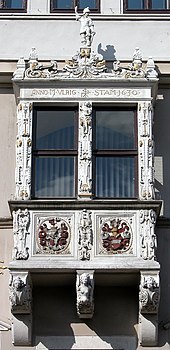Ulrich Stamm
Ulrich Stamm's first and last name ( “VLRIG STAM” ), his stonemason's mark and year ( “1630” ) when it was built.
Ulrich Stamm (* in Hohensyburg ; † December 16, 1633 (buried) in Braunschweig ) was a stonemason , sculptor and master builder in Braunschweig.
Life
Stamm came from Hohensyburg and was from April 28, 1617 new citizen of the Braunschweiger Weichbildes Altewiek and owned a house butt brothers; 1631 one in Gördelingerstrasse . He is alternately referred to as a stonemason, bricklayer or, on May 8, 1631, in the martini church's baptismal register as a sculptor. After his death he was buried at the Martinikirche. His widow had an illegitimate son with Wilhelm Schorigus the Elder. Ä. , a sculptor in Braunschweig.
plant

Only a few works are attested by Stamm. Evidence of stone masonry and masonry work has been found since 1622. His name and his stonemason's mark with the year 1630 can be found on the Achtermann House at Reichsstraße 3, which the merchant Georg Achtermann and his wife Lucia von Strombeck built from 1626 to 1630 in the Weichbild Neustadt . Further work cannot be proven.
Paul Jonas Meier concluded on the basis of the flat reliefs and the early Baroque shapes on the portal of the Stechinelli House on the Altstadtmarkt that it could have come from him. He also points out that Stechinelli did not build the house, but that, according to a source (Edicta 23, page 70), he bought it as early as 1654 by Dr. jur. I bought Krauthaupt and only expanded it in 1690. Meier also assumes that the former Kalmsche Haus at Wilhelmstrasse 95/96, which was a school in 1936, has similar features to the Achtermannsche Haus and could therefore also come from Stamm. This also applies to the portal of the author's yard and the portal of the Stegerschen Mumme-Haus at Bäckerklint 4 , which was totally destroyed in the war.
literature
- Horst-Rüdiger Jarck (Ed.): Braunschweigisches Biographisches Lexikon. 8th to 18th centuries , p. 669, Braunschweig 2006, ISBN 3-937664-46-7
- Paul Jonas Meier : The sculptor's handicrafts in the city of Braunschweig since the Reformation. In: Workpieces from the museum, archive and library of the City of Braunschweig VIII., Appelhans, Braunschweig 1936.
Individual evidence
- ↑ Horst-Rüdiger Jarck (Ed.): Braunschweigisches Biographisches Lexikon. 8th to 18th centuries , p. 669, Braunschweig 2006, p. 669
- ↑ Paul Jonas Meier: Das Kunsthandwerk, p. 71 (see literature)
| personal data | |
|---|---|
| SURNAME | Stamm, Ulrich |
| ALTERNATIVE NAMES | Stam |
| BRIEF DESCRIPTION | German sculptor and builder |
| DATE OF BIRTH | 16th Century |
| PLACE OF BIRTH | Hohensyburg |
| DATE OF DEATH | buried December 16, 1633 |
| Place of death | Braunschweig |